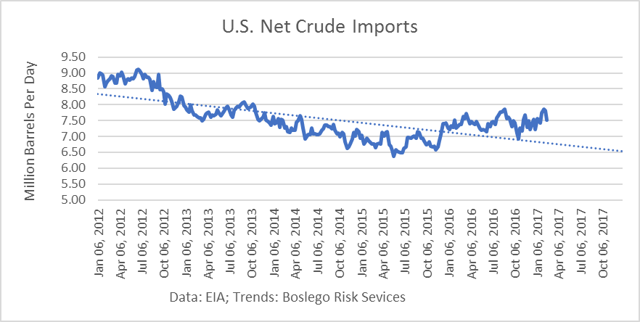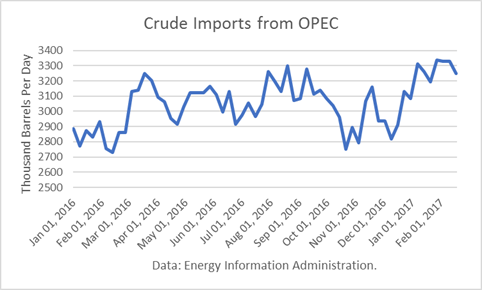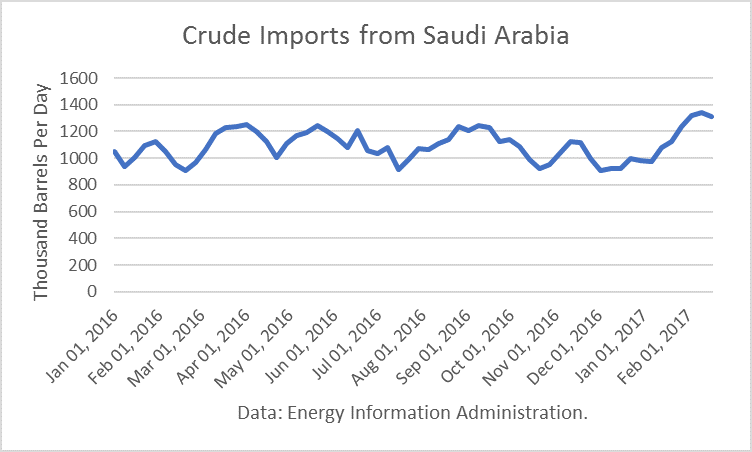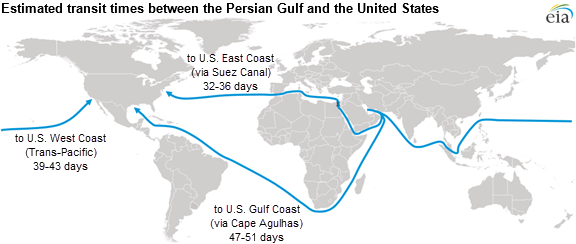
OPEC agreed to cut oil production by 1.164 million barrels per day beginning in January. Non-OPEC producers agreed to cut production around 560,000 b/d. The agreements were silent on exports.
Thus far, U.S. crude oil imports have been rising, despite the OPEC-non-OPEC cuts. In the year-to-date, net crude imports averaged 7.583 million barrels per day, up 2.7% v. the same period last year.

U.S. crude imports from OPEC, in total, and Saudi Arabia, in particular, remain at high levels seven weeks into the cut. Crude imports from OPEC countries averaged 3.248 mmbd over the past 4 weeks, 14% higher than the same weeks last year.

Imports from Saudi Arabia averaged 1.315 million barrels per day over the past 4 weeks, 45% higher than in the same weeks last year.

More than 90-percent of the cuts come from the Persian Gulf region. Based on this chart from the Energy Department, I calculated dates when we should be detecting the impact of the cuts on U.S. crude imports for those starting in January and February.


As indicated above, some effect should have already begun. But the impact on U.S. Gulf imports may be starting in the data to be released for the week ending February 24th.
The open questions are how OPEC members have cut exports, and how they will allocate their cuts to exports to destinations. OPEC has set reducing OECD stocks to their five-year averages as the goal of the cuts.
OECD stocks are estimated to be about 300 million barrels above their five-year averages. The U.S. has the largest surplus, about 180 million barrels.
The U.S. imports about 3 million barrels per day from OPEC countries. Venezuela has said it will keep its exports to the U.S. “steady,” and Nigeria is not subject to any output restrictions, so that leaves about 2 million barrels per day.
My base case is that OPEC will cut exports about 10%. That would be about 200,000 b/d. This impact would be mild because the U.S. is beginning to draw down the Strategic Petroleum Reserves (SPR) by about 100,000 b/d, and U.S. output is expected to rise as a result of the uptrend in the drilling rig count, and the completion of the Bakken Pipeline. Energy Transfer Partners (ETP) has estimated that the Dakota Access Pipeline will be complete and ready to flow oil anywhere between the week of March 6, 2017, and April 1, 2017. Based on my analysis, the pipeline could reduce the breakeven cost of 500,000 crude produced in the Bakken by about $5/b, thereby increasing production.
Two Theories
One theory is that OPEC members may intentionally target deeper cuts in exports to the U.S. than my base case. The rationale for that could be that the U.S. has the largest surplus of OECD stocks, and the U.S. data is the most timely and transparent in the world. Therefore, such a strategy would be most effective and timely in meeting its stated goal.
But another theory is that OPEC will intentionally target other destinations, leaving exports to the U.S. untouched. The rationale for that strategy is that OPEC does not want U.S. stocks to begin dropping quickly, thereby sending oil prices up too much, too quickly, thereby creating more of an incentive for shale oil producers to ramp-up production in America.
Another concern OPEC members, such as Saudi Arabia, may have is creating a wedge with the new Trump Administration by cutting exports in what could be seen as a "mini-embargo." Immediately upon taking office, the White House website was updated to state: "President Trump is committed to achieving energy independence from the OPEC cartel and any nations hostile to our interests."
The Saudi energy minister has said he would like to work with the new Energy Secretary when he is confirmed. Governor Perry is expected to be confirmed this week.
Conclusions
If OPEC exports are cut by my base case, or there is no cut according to the second theory above, I project we will see U.S. crude oil inventories continue to rise to new record highs this spring.
If the U.S. is targeted with much larger-than-proportional cuts, there may be a U.S. policy response. Congress had authorized the 200 million barrel drawdown in the SPR over a number of years for budgetary reasons. The drawdown could be accelerated to make up for the intentional cuts in exports targeted to the U.S.
During the nomination hearings, in a written question for the record, Senator Ed Markey (D-MA) asked Secretary of state nominee Rex Tillerson whether he agreed "that the United States should unequivocally reject any efforts by OPEC to collaborate to manipulate oil markets and take all measures within our power to reduce OPEC's ability to artificially limit production or increase prices." Secretary of State Tillerson answered “Yes.”
Check back to see my next post!
Best,
Robert Boslego
INO.com Contributor - Energies
Disclosure: This contributor does not own any stocks mentioned in this article. This article is the opinion of the contributor themselves. The above is a matter of opinion provided for general information purposes only and is not intended as investment advice. This contributor is not receiving compensation (other than from INO.com) for their opinion.

I've heard that a good bit of our oil is being brought in from Canada. Am I hearing wrong or do I wait for the poloticos to get their hands into the pot????? As a bourn citizen of this country I am getting more and more disagreeable of the people I have voted for. May it's time for a coup!!!!!!!! unfortunatly I am to old to particapate in such an action. It's a durn shame we are being led around by the nose with those of you that have the control and when it hits the fan don't knock on my door for saftey or a meal.